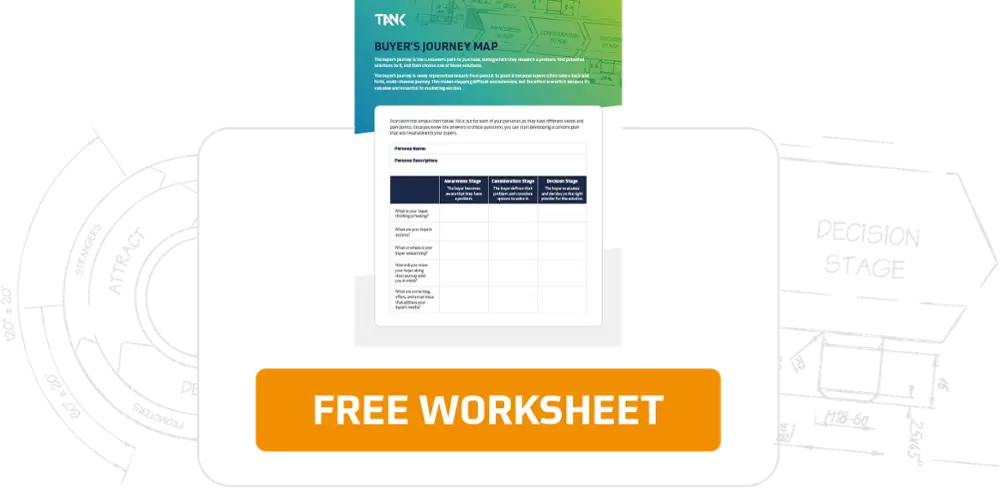The Buyer's Journey Sets the Stage for Effective Marketing
 Kristen
|
Kristen
|

For business growth in a digital world, buyers must be at the center of every effort.
The buyer's journey helps categorize and conceptualize the way buyers process information, starting as a prospect and ending as a customer. While it's best known within the inbound marketing world and discussed at length by HubSpot (a developer of software products for inbound marketing, sales, and customer service), it's an idea that every owner, marketer, and sales rep across industries and methodologies should understand.
In this article, we'll take a look at the definition of the buyer's journey, its stages, and importance, plus who benefits from the buyer's journey, how to create a buyer's journey map, and how the buyer's journey fits into inbound marketing and HubSpot to create the ultimate marketing machine.
Buyer’s Journey Definition, Stages, & Importance
For businesses to successfully grow in today's digital world, owners, marketers, and sales reps are forced to shift their mindset from selling to helping. The best way to start this process is to become familiar with buyers and how they make a purchase. We refer to this as the buyer's journey.
Within the buyer’s journey, customers identify their problem, research potential solutions, then choose a solution. Each is addressed in three main stages: awareness, consideration, and decision.
- Awareness Stage: The buyer becomes aware that they have a problem.
- Consideration Stage: The buyer defines their problem and considers options to solve it.
- Decision Stage: The buyer evaluates and decides on the right provider for the solution.

By providing value and answers at every stage, customers can be nurtured toward making a decision. If done right, the decision will be to buy a solution from your company, not a competitor.
Who Benefits from the Buyer’s Journey?
Businesses and customers both benefit from the buyer's journey. Customers win because they're able to find answers to their questions and solutions to their problems. Businesses win because the customers they're nurturing are likely going to decide to buy from them.
To use the buyer's journey effectively, you have to know your target customers or personas. Your product or service serves a specific purpose and solves a particular problem. Take a few minutes to articulate exactly what problem your product or service solves and what groups of people benefit from it the most (e.g., engineers, business owners, operations managers, etc.). Consider why they would need your product, how your product or service makes their life/work better, etc.
Once you know what problem your product or service solves and who would benefit from it, write down all the attributes for that person or persona. For instance, if you're targeting engineers, what does a day in their life look like? What challenges do they face? What do they value? Where do they spend their time? If you need a template for this activity, here is a workbook that helps guide you through the process.
No matter what your company sells, buyer personas are the groundwork for all effective marketing strategies. Building trust is crucial for customers who are researching then committing to a product or service. Knowing your personas — their pain points, challenges, and feelings — allows you to communicate with them in a relevant and helpful way while offering them solutions to their problems at every stage of the journey, whether it's through blog posts, content offers, or emails.
How to Create a Buyer’s Journey Map
The buyer's journey is rarely represented linearly from point A to point B because buyers often take a back and forth, multi-channel journey. This makes mapping difficult and extensive, but the effort is worth it because it's valuable and essential to marketing success. Starting with a simple chart is a good first step. It allows you to collect your thoughts in one place.
Download this helpful template and fill one out for each of your personas.
While filling out the template, consider listing potential blog posts, offers, and email ideas that address buyer problems and naturally push to the next stage in the journey. For instance, a labeling machine company could create a journey for a beverage operations manager that includes:
- An awareness-level checklist of potential issues that often slow down beverage packaging lines
- A consideration-level blog post that focuses on why and how upgrading beverage labelers can increase output and decrease downtime
- A decision-level chart with a side-by-side comparison of the company's beverage wrap-around and shrink sleeve labelers
As a next step, the decision offer could encourage buyers to download a product catalog, view product website pages, or request a machine quote.
How the Buyer’s Journey, Inbound Marketing & HubSpot Work Together
Before connecting the buyer's journey to inbound marketing or HubSpot, let's define each briefly.
Inbound marketing is a methodology that focuses on creating digital content that resonates with buyer personas and compels them to engage because they believe it will help them solve a problem. This marketing method nurtures buyers until they're ready to buy. By understanding buyers and their needs, inbound marketing provides specific and valuable information.
Every part of inbound marketing (SEO, blogging, content offers, emails, etc.) relies on knowing buyer personas, their problems, and how to address them in helpful ways along each stage of the journey.
How Inbound Marketing Fuels Growth for Manufacturing Businesses
One platform made specifically for inbound marketing and capable of supporting every aspect of it is HubSpot.
HubSpot is a one-stop-shop for all inbound efforts, including content offers, blog posts, and emails that nurture customers through the buyer's journey. Plus, it has analytics tools and ROI reports to help you see how efforts are working and where they can be improved. Executing inbound marketing using the framework of the buyer's journey has never been easier or more effective. Why Use HubSpot: The Benefits of HubSpot Marketing Software
Subscribe to Our Blog
Stay up to date with the latest marketing, sales, and service tips.




